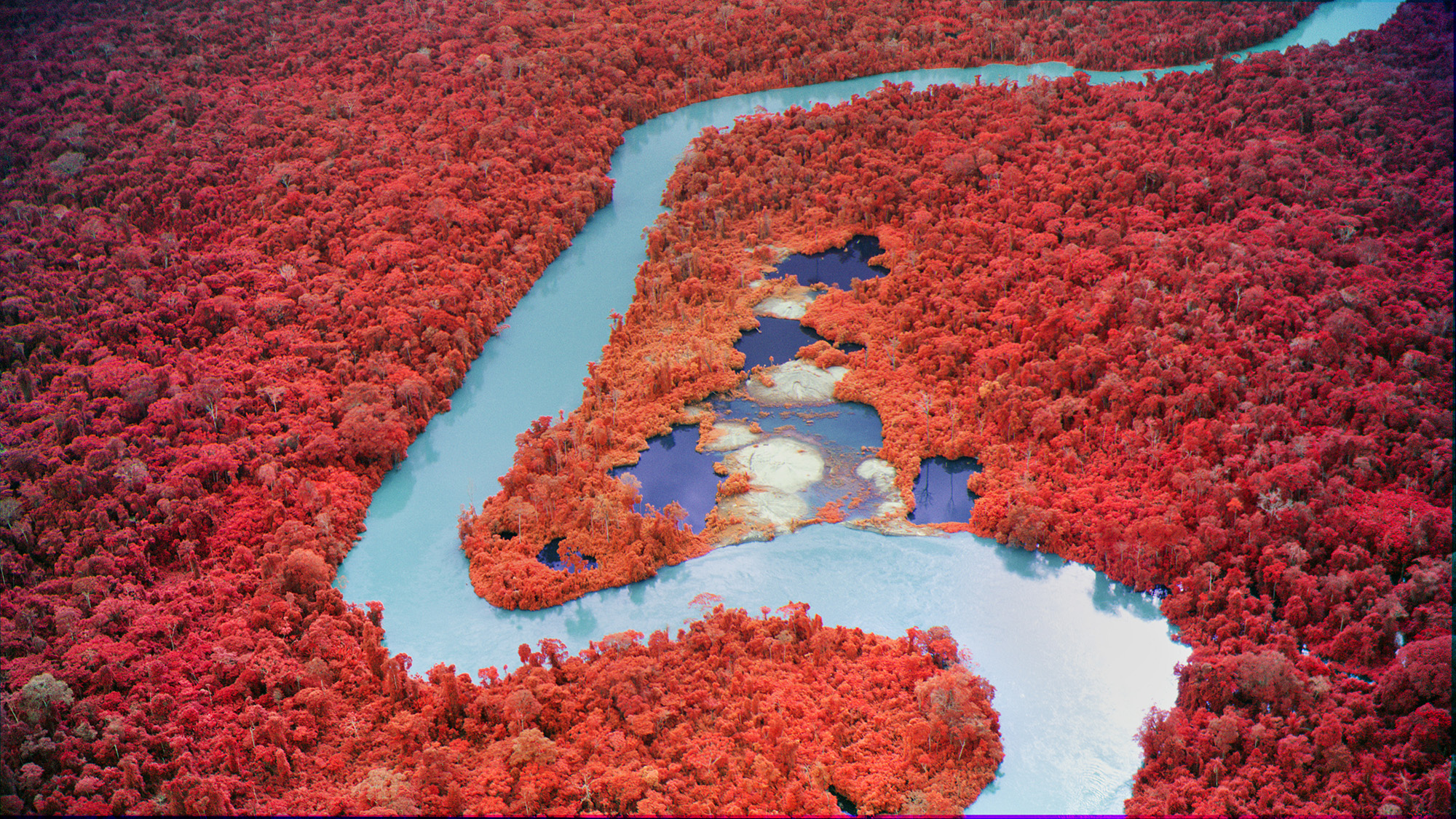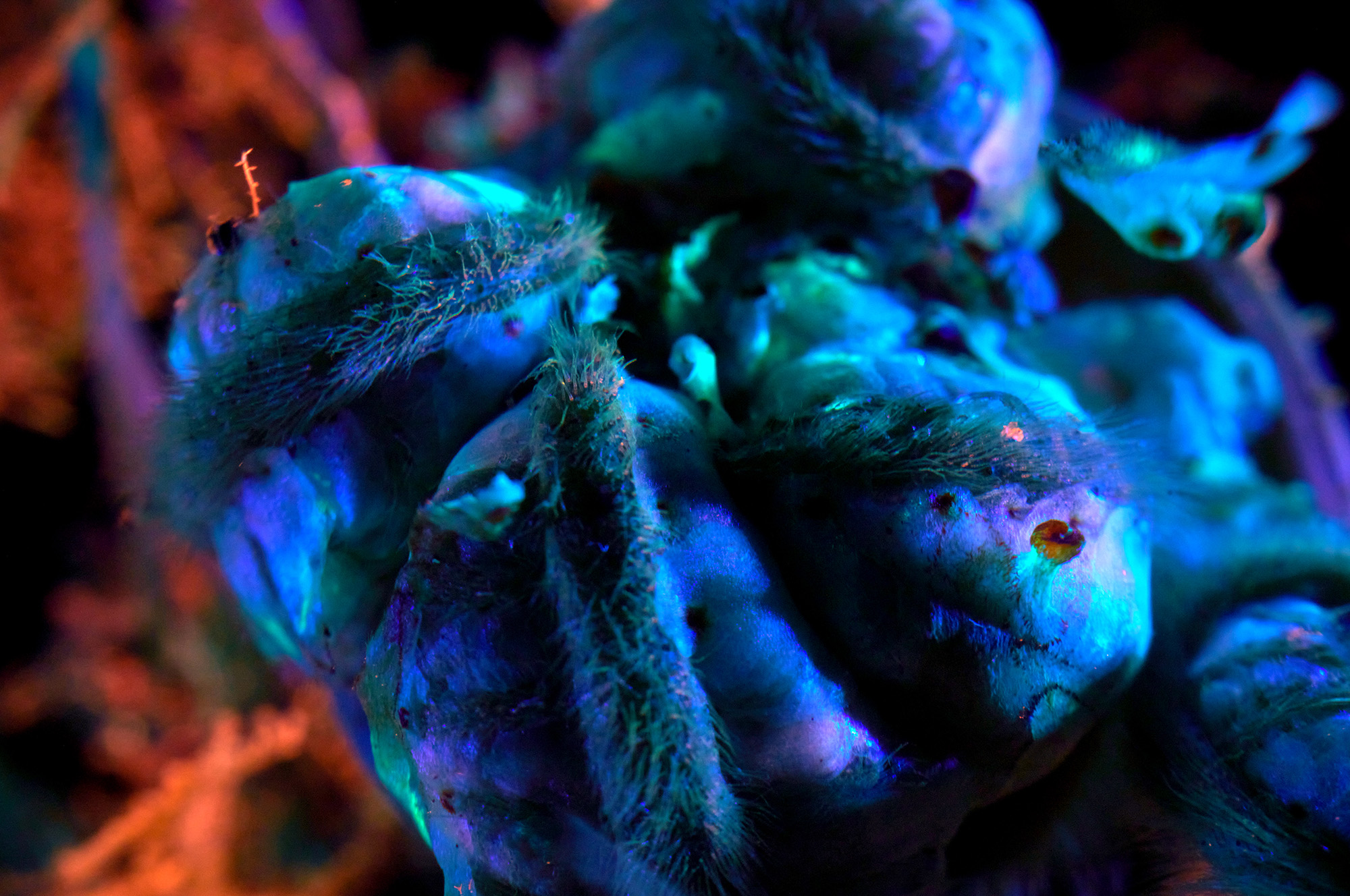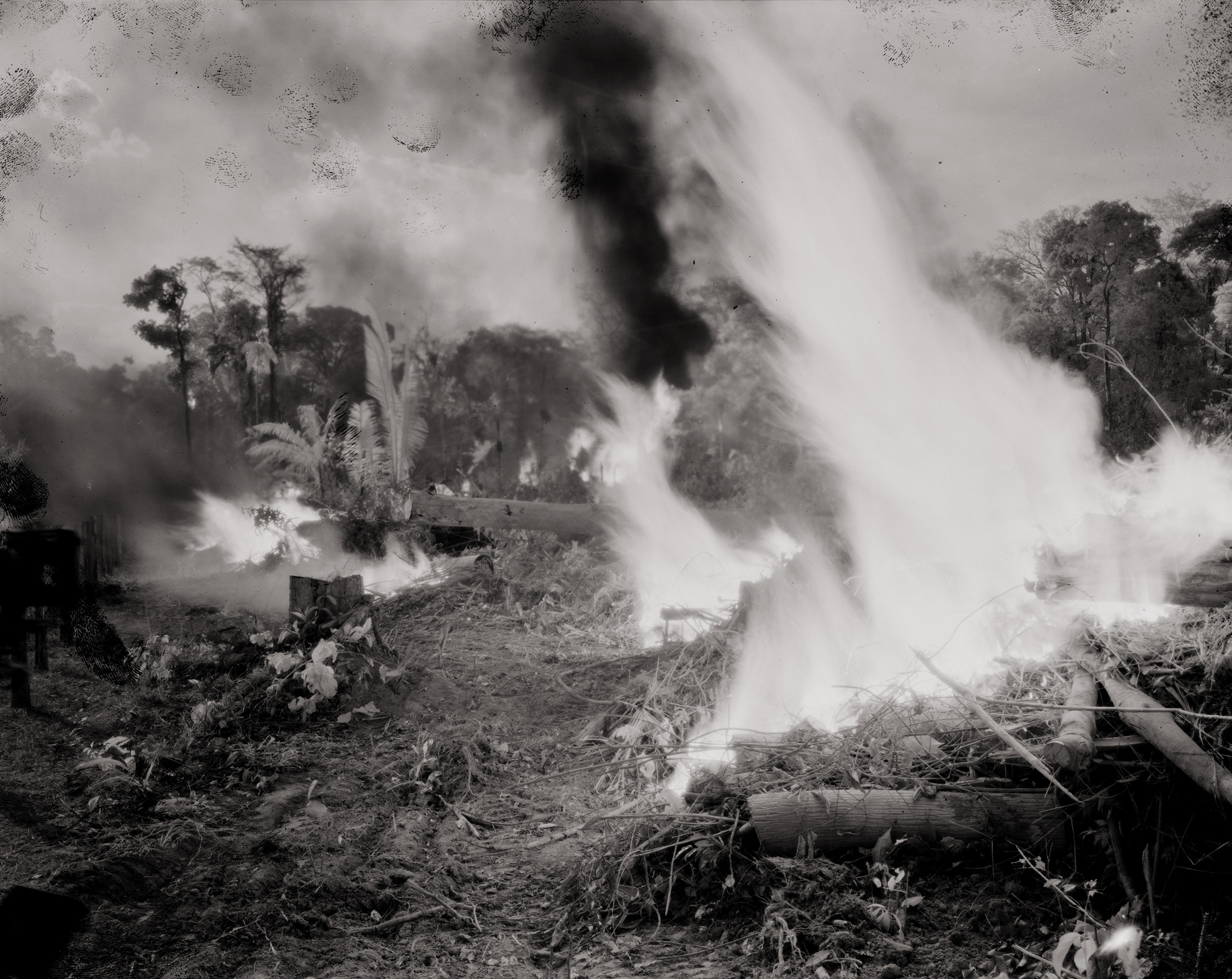After nature: Richard Mosse’s study of Amazonian extraction
Irish photographer Richard Mosse has created a study of the extractive and violent industries secreted within the vastness of the Amazon rainforest. In an installation of still and a five-channel film at 180 Strand, Mosse is part journlist part artist in a traumatic and devastating gaze into the jungle after nature.
As
an artist whose work evokes rich storytelling across both overarching theme and
within a single image, it’s perhaps not surprising that photography was only
Mosse’s third degree. His first was in English Literature, which he studied at
Kings College London, just a few doors away 180 Strand where his latest body of
work is exhibited to coincide with Frieze week. His second stage of education
was an MRes in Cultural Studies from the London Consortium, before his 2008 photography
MFA from Yale School of Art.
As such, there’s richness and depth to Mosse’s work speaking to that broader research and a rounder reading of subject. In its installation and design, it carries a strong fine art mediation, but beyond the formal modes of exhibition and publication his work is deeply researched with a situated journalistic approach embedded within.
That journo-artistic inquiry has recently taken him to the Amazon rainforest, with a traumatic yet beautiful rendering of place, process, and situation at a critical time for not only Brazil but Earth. Opening over Frieze art fair week, within 180 Strand, Broken Spectre is a photographic series and film exploring the industrialisation and extraction of the rainforest, ahead of a vast and richly choregraphed film in which Mosse’s camera oscillates between granular detail and landscape vastness, journalistic documentary and artistic obliqueness.
![]()
![]()
The photographs on display employ his trademark use of Kodak false-colour infrared film and other scientific apparatus, Mosse registers landscape in ways invisible to the human eye. Trees and natural life is revealed in red, while areas where there is a lack of life fall into a shaded darkness, and so Mosse’s drone shots looking down upon the Amazon treetops reveal where environmental crimes have cut into and devastated the richness of the jungle.
There is a distance in the gaze of Mosse’s photography and film beyond the aerial drone footage which show both the jungle’s immensity and precarity. His film includes close up shots dispassionately following the industrial processes of the jungle with a journalistic gaze. As cattle workers move herds from ranch to shed to abattoir, the camera silently follows at a smooth pace belying the violent and brutal activities portrayed. Mosse is seemingly not overtly passing judgement, though the viewer probably is.
![]()
![]()
This coldness of reportage is most present in a scene in which the camera follows the illegal burning of forests to create clearances for cattle farming. As masked workers urgently take burning torches to dry grasses, the camera follows at pace, the viewer can’t help feel like an accomplice. Before soon, both trees and screen are full of flames, the smoke lingering across a nearby highway, causing lorries to engage full-beam headlights to cut through the jungle.
![]()
fig.v
Mosse has previously been accused of overly beautifying violence, not least with his 2014 Deutsche Börse Photography Prize winning works documenting violence and war in DR Congo, and some of the imagery – whether black and white documenting the processes or the rich colour and large-format images recording the scenes – is indeed sublime. But within the sublime is an inherent fear and terror.
While predominantly a study of a kind of landscape architecture, the appearance of nature concealing a deeply man-affected and man-made environment, built architecture recurs within the photographs and film. In the centre of a three-panel large-format aerial photograph, a swimming pool behind a small home implies the wealth some make from extraction and felling.
![]()
fig.vi
The house is in a cluster of buildings in the town of Senador José Porfírio, a centre of sawmills and largely-illegal tropical hardwood production. Rooftops are arranged amongst woods, whether the red hues of the still-growing trees, or the darkness of felled and stacked trunks awaiting shipment. In other instances, architecture is present by its effect. Submerged Forest, Rondônia is an aerial vantage of forest now underwater due to a nearby hydropower dam, dead wood jutting from the still water, a drowned ecology.
![]()
![]()
![]()
![]()
![]()
Mosse’s five-channel film, Broken Spectre, constantly flickers between manmade architectural environments and the natural landscape within which they are forced. The footage is restless, with macro views of richly shot documentary footage of workers carrying out they're industrial tasks cutting into close ups of the jungle floor. The wide screen aesthetic sucks the viewer into rich detail of nature, insect, earth, compressing one’s personal ethics within the trauma revealed on screen, much to the credit of cinematographer Trevor Tweeten.
![]()
![]()
figs.xii,xiii
The artist’s infra-red and scientific photographic processes turn footage of nature into psychedelic animation, underpinned by a base-heavy soundscape by composer Ben Frost. It does not allow rest, flitting between single frame, diptych, then triptych, we switch between bright colour nature footage to black and white documentary observing dramatic violence as a tree is felled, bass thundering through the gallery as it collapses to the jungle floor.
Drone footage of richly red tree cover slowly reveals patches of darkness where trees have been cleared through illegal burning, which as the camera passes over the landscape gives way to wide open expanses of near-blackness where there are no trees and no life but occasional small red dots - cattle grazing in what was once deep jungle. The colourisation, or lack of it, highlights a landscape of death and process, industry after nature.
![]()
![]()
![]()
.
As such, there’s richness and depth to Mosse’s work speaking to that broader research and a rounder reading of subject. In its installation and design, it carries a strong fine art mediation, but beyond the formal modes of exhibition and publication his work is deeply researched with a situated journalistic approach embedded within.
That journo-artistic inquiry has recently taken him to the Amazon rainforest, with a traumatic yet beautiful rendering of place, process, and situation at a critical time for not only Brazil but Earth. Opening over Frieze art fair week, within 180 Strand, Broken Spectre is a photographic series and film exploring the industrialisation and extraction of the rainforest, ahead of a vast and richly choregraphed film in which Mosse’s camera oscillates between granular detail and landscape vastness, journalistic documentary and artistic obliqueness.


figs.i,ii
The photographs on display employ his trademark use of Kodak false-colour infrared film and other scientific apparatus, Mosse registers landscape in ways invisible to the human eye. Trees and natural life is revealed in red, while areas where there is a lack of life fall into a shaded darkness, and so Mosse’s drone shots looking down upon the Amazon treetops reveal where environmental crimes have cut into and devastated the richness of the jungle.
There is a distance in the gaze of Mosse’s photography and film beyond the aerial drone footage which show both the jungle’s immensity and precarity. His film includes close up shots dispassionately following the industrial processes of the jungle with a journalistic gaze. As cattle workers move herds from ranch to shed to abattoir, the camera silently follows at a smooth pace belying the violent and brutal activities portrayed. Mosse is seemingly not overtly passing judgement, though the viewer probably is.


figs.ii,iv
This coldness of reportage is most present in a scene in which the camera follows the illegal burning of forests to create clearances for cattle farming. As masked workers urgently take burning torches to dry grasses, the camera follows at pace, the viewer can’t help feel like an accomplice. Before soon, both trees and screen are full of flames, the smoke lingering across a nearby highway, causing lorries to engage full-beam headlights to cut through the jungle.

fig.v
Mosse has previously been accused of overly beautifying violence, not least with his 2014 Deutsche Börse Photography Prize winning works documenting violence and war in DR Congo, and some of the imagery – whether black and white documenting the processes or the rich colour and large-format images recording the scenes – is indeed sublime. But within the sublime is an inherent fear and terror.
While predominantly a study of a kind of landscape architecture, the appearance of nature concealing a deeply man-affected and man-made environment, built architecture recurs within the photographs and film. In the centre of a three-panel large-format aerial photograph, a swimming pool behind a small home implies the wealth some make from extraction and felling.

fig.vi
The house is in a cluster of buildings in the town of Senador José Porfírio, a centre of sawmills and largely-illegal tropical hardwood production. Rooftops are arranged amongst woods, whether the red hues of the still-growing trees, or the darkness of felled and stacked trunks awaiting shipment. In other instances, architecture is present by its effect. Submerged Forest, Rondônia is an aerial vantage of forest now underwater due to a nearby hydropower dam, dead wood jutting from the still water, a drowned ecology.





figs.vii-xi
Mosse’s five-channel film, Broken Spectre, constantly flickers between manmade architectural environments and the natural landscape within which they are forced. The footage is restless, with macro views of richly shot documentary footage of workers carrying out they're industrial tasks cutting into close ups of the jungle floor. The wide screen aesthetic sucks the viewer into rich detail of nature, insect, earth, compressing one’s personal ethics within the trauma revealed on screen, much to the credit of cinematographer Trevor Tweeten.


figs.xii,xiii
The artist’s infra-red and scientific photographic processes turn footage of nature into psychedelic animation, underpinned by a base-heavy soundscape by composer Ben Frost. It does not allow rest, flitting between single frame, diptych, then triptych, we switch between bright colour nature footage to black and white documentary observing dramatic violence as a tree is felled, bass thundering through the gallery as it collapses to the jungle floor.
Drone footage of richly red tree cover slowly reveals patches of darkness where trees have been cleared through illegal burning, which as the camera passes over the landscape gives way to wide open expanses of near-blackness where there are no trees and no life but occasional small red dots - cattle grazing in what was once deep jungle. The colourisation, or lack of it, highlights a landscape of death and process, industry after nature.



figs.xiv-xvi
.
Richard Mosse was born in 1980 in Ireland and is based in New York. He earned an MFA in Photography from Yale School of Art in 2008 and a Postgraduate Diploma in Fine Art from Goldsmiths, London in 2005. His work has been the subject of recent solo exhibitions at San Francisco Museum of Modern Art, the National Gallery of Art in Washington DC, Barbican Art Gallery in London, and the National Gallery of Victoria in Melbourne. Recent survey exhibitions were held at Kunsthalle Bremen (2022) and MAST Foundation, Bologna (2021). Recent group exhibitions include Kunstmuseum Basel; ICA Boston; Minneapolis Institute of Art; Akademie der Kunst, Berlin; Hamburger Kunsthalle; Museum für Moderne Kunst, Frankfurt; National Museum of Modern and Contemporary Art, Seoul; Denver Art Museum; Salaam Kivu International Film Festival, Goma; The Victoria and Albert Museum, London.
Mosse was the recipient of the Prix Pictet 2017 and winner of the 2014 Deutsche Börse Photography Prize. In 2013, he represented Ireland in the Venice Biennale with The Enclave an immersive six-channel video installation that utilized 16mm infrared film.
www.richardmosse.com
180 Studios is the emerging centre of London’s creative community. The Studios are housed at 180 The Strand, an iconic Brutalist building that has been transformed into a cultural hub. Throughout its network of exhibition spaces, 180 supports new and emerging artistic talent and has commissioned new works by artists such as Ryoji Ikeda, Es Devlin, Hito Steyerl, Kahlil Joseph, United Visual Artists, Caterina Barbieri, Jenn Nkiru Gabriel Moses and Julianknxx.
180 The Strand is also home to The Store X, Fact Space, Toklas and Reference Point, as well as the base for many other creatively led businesses and London’s flagship Soho Works and 180 House.
www.180thestrand.com
180 The Strand is also home to The Store X, Fact Space, Toklas and Reference Point, as well as the base for many other creatively led businesses and London’s flagship Soho Works and 180 House.
www.180thestrand.com
visit
Broken Spectre, by Richard Mosse, is on at 180 Studios at 180 Strand until 04 December 2022. Information at:
www.180thestrand.com/richard-mosse
images
figs.i-v Still from Broken Spectre (2022), five channel 4K video with 20.4 surround sound.
Courtesy of the artist, Jack Shainman Gallery, New York and carlier | gebauer, Berlin/Madrid.
© Richard Mosse. Co-commissioned by the National Gallery of Victoria, VIA Art Fund, the Westridge Foundation and Serpentine Galleries.
fig.vi Richard Mosse, Broken Spectre (2022). Photo by Jack Hems.
figs.vii-xiii
Still from Broken Spectre (2022), five channel 4K video with 20.4 surround sound.
Courtesy of the artist, Jack Shainman Gallery, New York and carlier | gebauer, Berlin/Madrid.
© Richard Mosse. Co-commissioned by the National Gallery of Victoria, VIA Art Fund, the Westridge Foundation and Serpentine Galleries.
fig.xiv
Richard Mosse, Broken Spectre (2022). Photo by Jack Hems.
figs.xv,xvi
Still from Broken Spectre (2022), five channel 4K video with 20.4 surround sound.
Courtesy of the artist, Jack Shainman Gallery, New York and carlier | gebauer, Berlin/Madrid.
© Richard Mosse. Co-commissioned by the National Gallery of Victoria, VIA Art Fund, the Westridge Foundation and Serpentine Galleries.
publication date
10 October 2022
tags
180 Strand. Amazon, Extraction, Farming, Film, Richard Mosse, Fire, Frieze, Industry, Will Jennings, Jungle, Nature, Photography, Ranch, Rainforest
www.180thestrand.com/richard-mosse


